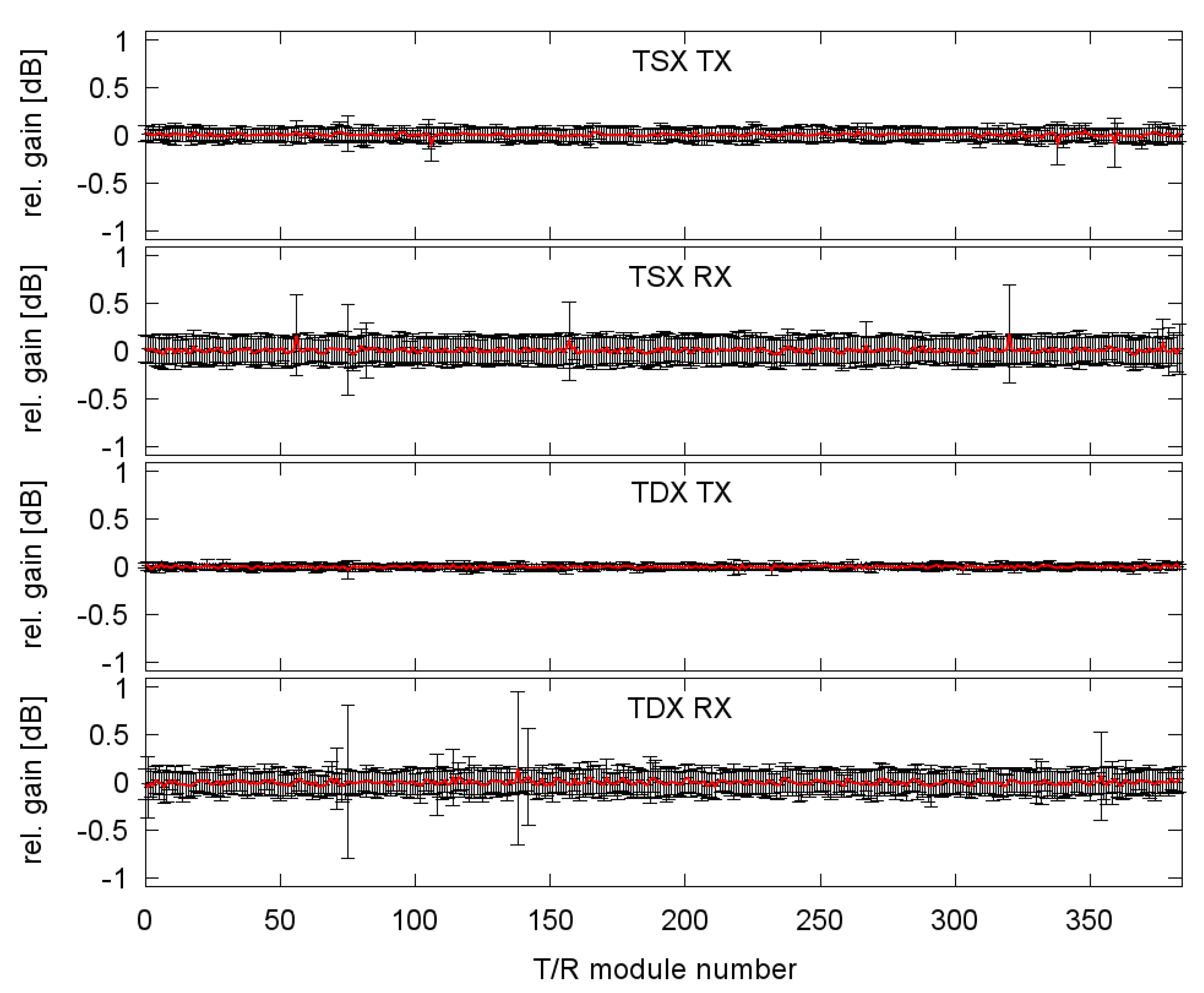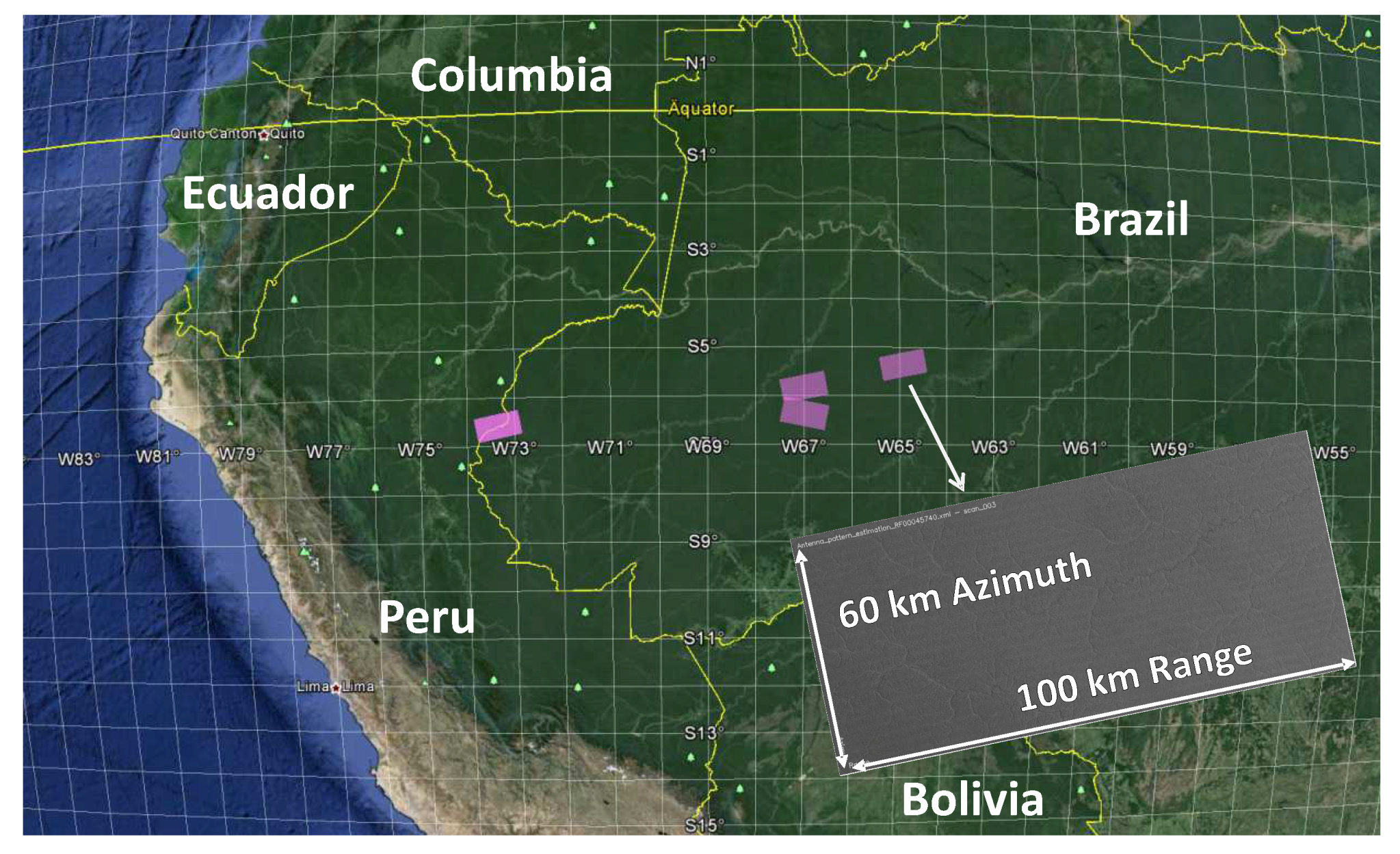Radiometric Performance of the TerraSAR-X Mission over More Than Ten Years of Operation
Abstract
:1. Introduction
- characterizing the gain and phase stability of TRMs (Section 2) by means of coded calibration pulses,
- monitoring the antenna characteristics by evaluating scenes acquired over distributed targets like the Amazon rain forest (Section 3) and
- analyzing the radiometric stability by means of impulse response functions derived from permanently installed corner reflectors (Section 4).
2. Stability of Individual Transmit/Receiver Modules
3. Antenna-Pattern Monitoring
4. Radiometric Stability
5. Image Quality
- integrated side lobe ratio (ISLR),
- peak-to-side lobe ratio (PSLR) and
- geometric resolution derived by the main lobe width at –3 dB.
6. Conclusions
Author Contributions
Acknowledgments
Conflicts of Interest
Abbreviations
| DLR | German Aerospace Center |
| IRF | Impulse Response Function |
| ISLR | Integrated Side Lobe Ratio |
| LTSM | Long Term System Moniotring |
| PN | Pseudo Noise |
| PSLR | Peak to Side Lobe Ratio |
| RCS | Radar Cross Section |
| RX | Reception |
| SAR | Synthetic Aperture Radar |
| TDX | Second Satellite of the TerraSAR-X Mission |
| TRM | Transmit/Receiver Module |
| TSX | First Satellite of the TerraSAR-X Mission |
| TX | Transmission |
References
- Buckreuss, S.; Werninghaus, R.; Pitz, W. The German Satellite Mission TerraSAR-X. In Proceedings of the 2008 IEEE Radar Conference, Rome, Italy, 26–30 May 2008; pp. 306–310. [Google Scholar]
- Zink, M.; Bartusch, M.; Miller, D. TanDEM-X Mission Status. In Proceedings of the 30th International Geoscience And Remote Sensing Symposium, Vancouver, BC, Canada, 24–29 July 2011. [Google Scholar]
- Kraus, T.; Bräutigam, B.; Mittermayer, J.; Wollstadt, S.; Grigorov, C. TerraSAR-X Staring Spotlight Mode Optimization and Global Performance Predictions. IEEE J. Sel. Top. Appl. Earth Observ. Remote Sens. 2016, 9, 1015–1027. [Google Scholar] [CrossRef]
- Buckreuss, S.; Schättler, B.; Fritz, T.; Steinbrecher, U.; Böer, J.; Bachmann, M.; Mittermayer, J.; Maurer, E.; Kahle, R.; Mrowka, F.; et al. Ten Years of TerraSAR-X Operations. Remote Sens. 2018. under review. [Google Scholar]
- Schwerdt, M.; Bräutigam, B.; Bachmann, M.; Döring, B.; Schrank, D.; Gonzalez, J.H. Final TerraSAR-X Calibration Results Based on Novel Efficient Calibration Methods. IEEE Trans. Geosci. Remote Sens. 2010, 48, 677–689. [Google Scholar] [CrossRef]
- Schwerdt, M.; Gonzalez, J.H.; Bachmann, M.; Schrank, D.; Döring, B.; Ramon, N.T.; Antony, J.W. In-Orbit Calibration of the TanDEM-X System. In Proceedings of the 2011 IEEE International Geoscience and Remote Sensing Symposium, Vancouver, BC, Canada, 24–29 July 2011; pp. 2420–2423. [Google Scholar]
- Schwerdt, M.; Schrank, D.; Bachmann, M.; Schulz, C.; Döring, B.; Gonzalez, J.H. TerraSAR-X Re-Calibration and Dual Receive Antenna Campaigns performed in 2009. In Proceedings of the 8th European Conference on Synthetic Aperture Radar, Aachen, Germany, 7–10 June 2010. [Google Scholar]
- Grafmüller, B.; Herschlein, A.; Fischer, C. The TerraSAR-X Antenna System. In Proceedings of the 2005 IEEE International Radar Confrerence, Arlington, VA, USA, 9–12 May 2005; pp. 222–225. [Google Scholar]
- Stangl, M.; Werninghaus, R.; Schweizer, B.; Fischer, C.; Brandfass, M.; Mittermayer, J.; Breit, H. TerraSAR-X Technologies and First Results. IEE Radar Sonar Navig. 2006, 153, 86–95. [Google Scholar] [CrossRef]
- Schwerdt, M.; Hounam, D.; Alvarez-Pérez, J.L.; Molkenthin, T. The Calibration Concept of TerraSAR-X, a Multiple Mode High Resolution SAR. Can. J. Remote Sens. 2005, 31, 30–36. [Google Scholar] [CrossRef]
- Döring, B.; Schwerdt, M.; Bauer, R. TerraSAR-X Calibration Ground Equipment. In Proceedings of the European Radar Conference, Munich, Germany, 10–12 October 2007. [Google Scholar]
- Bräutigam, B.; Rizzoli, P.; González, C.; Schulze, D.; Schwerdt, M. SAR Performance of TerraSAR-X Mission with Two Satellites. In Proceedings of the 8th European Conference on Synthetic Aperture Radar, Aachen, Germany, 7–10 June 2010. [Google Scholar]
- Bräutigam, B.; Schwerdt, M.; Bachmann, M. An Efficient Method for Performance Monitoring of Active Phased Array Antennas. IEEE Trans. Geosci. Remote Sens. 2009, 47, 1236–1243. [Google Scholar] [CrossRef] [Green Version]
- Bachmann, M.; Schwerdt, M.; Brautigam, B. TerraSAR-X Antenna Calibration and Monitoring Based on a Precise Antenna Model. IEEE Trans. Geosci. Remote Sens. 2010, 48, 690–701. [Google Scholar] [CrossRef]
- Tous-Ramon, N.; Schrank, D.; Bachmann, M.; Alfonzo, G.C.; Polimeni, D.; Böer, J.; Schwerdt, M. Long Term System Monitoring Status of the TerraSAR-X and the TanDEM-X Satellites. In Proceedings of the 9th European Conference on Synthetic Aperture Radar, Nuremberg, Germany, 23–26 April 2012; pp. 1–4. [Google Scholar]
- Hounam, D.; Schwerdt, M.; Zink, M. Active Antenna Module Characterisation by Pseudo-Noise Gating. In Proceedings of the 25th ESA Antenna Workshop on Satellite Antenna Technology, Noordwijk, The Netherlands, 18–20 September 2002. [Google Scholar]
- Bachmann, M.; Schwerdt, M.; Bräutigam, B. Accurate Antenna Pattern Modeling for Phased Array Antennas in SAR Applications—Demonstration on TerraSAR-X. Int. J. Antennas Propag. 2009, 2009, 492505. [Google Scholar] [CrossRef]
- Rizzoli, P.; Bräutigam, B.; Zink, M. TanDEM-X Large-Scale Study of Tropical Rainforest for Spaceborne SAR Calibration in X-Band. In Proceedings of the 10th European Conference on Synthetic Aperture Radar, Berlin, Germany, 3–5 June 2014; pp. 1–4. [Google Scholar]
- Danklmayer, A.; Döring, B.; Schwerdt, M.; Chandra, M. Assessment of Atmospheric Propoagation Effects in SAR Images. IEEE Trans. Geosci. Remote Sens. 2009, 47, 3507–3518. [Google Scholar] [CrossRef]










| Mean of the -values of all TRMs | TX | RX | ||
|---|---|---|---|---|
| Amplitude (dB) | Phase () | Amplitude (dB) | Phase () | |
| TSX | 0.08 | 1.97 | 0.16 | 1.16 |
| TDX | 0.03 | 1.67 | 0.14 | 1.05 |
| Cal Procedure | Goal | TSX | TDX |
|---|---|---|---|
| Internal Calibration | |||
| Amplitude | 0.25 dB | <0.1 dB | <0.1 dB |
| Phase | 1.0 deg | <1.0 deg | <1.0 deg |
| TRM Setting Characterization | |||
| Amplitude | - | <0.2 dB | <2 deg |
| Phase | - | <0.2 dB | <2 deg |
| Antenna Model Verification | |||
| Pattern Shape | ±0.2 dB | ±0.2 dB | ±0.2 dB |
| Beam-to-Beam Gain Offset | ±0.2 dB | ±0.2 dB | ±0.2 dB |
| Radiometric Calibration | |||
| Radiometric Stability | 0.5 dB * | <0.15 dB ** | <0.15 dB ** |
| Relative Accuracy | 0.68 dB | ≤ 0.18 dB | ≤0.17 dB |
| Absolute Accuracy | 1.1 dB | <0.34 dB | <0.33 dB |
© 2018 by the authors. Licensee MDPI, Basel, Switzerland. This article is an open access article distributed under the terms and conditions of the Creative Commons Attribution (CC BY) license (http://creativecommons.org/licenses/by/4.0/).
Share and Cite
Schwerdt, M.; Schmidt, K.; Klenk, P.; Tous Ramon, N.; Rudolf, D.; Raab, S.; Weidenhaupt, K.; Reimann, J.; Zink, M. Radiometric Performance of the TerraSAR-X Mission over More Than Ten Years of Operation. Remote Sens. 2018, 10, 754. https://doi.org/10.3390/rs10050754
Schwerdt M, Schmidt K, Klenk P, Tous Ramon N, Rudolf D, Raab S, Weidenhaupt K, Reimann J, Zink M. Radiometric Performance of the TerraSAR-X Mission over More Than Ten Years of Operation. Remote Sensing. 2018; 10(5):754. https://doi.org/10.3390/rs10050754
Chicago/Turabian StyleSchwerdt, Marco, Kersten Schmidt, Patrick Klenk, Núria Tous Ramon, Daniel Rudolf, Sebastian Raab, Klaus Weidenhaupt, Jens Reimann, and Manfred Zink. 2018. "Radiometric Performance of the TerraSAR-X Mission over More Than Ten Years of Operation" Remote Sensing 10, no. 5: 754. https://doi.org/10.3390/rs10050754
APA StyleSchwerdt, M., Schmidt, K., Klenk, P., Tous Ramon, N., Rudolf, D., Raab, S., Weidenhaupt, K., Reimann, J., & Zink, M. (2018). Radiometric Performance of the TerraSAR-X Mission over More Than Ten Years of Operation. Remote Sensing, 10(5), 754. https://doi.org/10.3390/rs10050754





